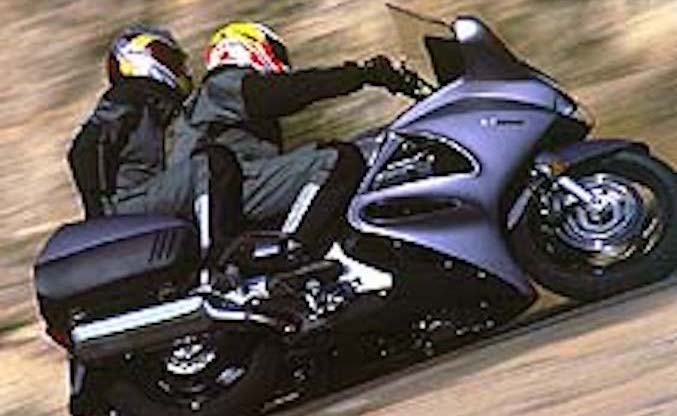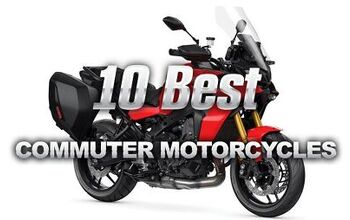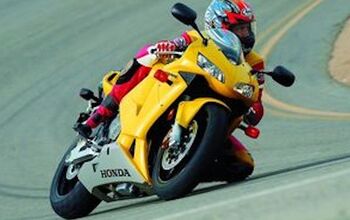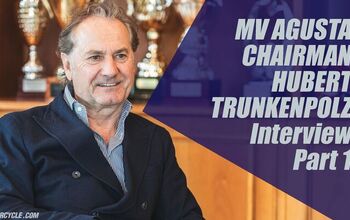Church of MO: 2003 Honda ST1300
1990 Honda ST1100 begat 2003 Honda ST1300, which begat 2014 Honda CTX1300… which at some point in the last few years seems to have gone, mercifully, the way of all flesh. Now if it’s a Honda sport tourer you crave, it’s the Gold Wing or, well, that’s about it. Anyway, the big 1261cc V-four ST1300 was quite the long-distance mile muncher 20 years ago. But I can’t remember the last time I’ve seen one in the wild. The good news is Yamaha is still manufacturing the motorcycle that showed the ST the exit – the FJR1300ES. Survival of the fittest, I suppose.
With special guest appearance by Lisa Delaney, as The Passenger.
More power, less weight, better handling. What’s not to Like? Don’t ask…
Well, you didn’t really think the long-awaited ST1300 was going to suck or anything did you? Of course not. It’s a very nice motorcycle. Then again, there are parts of it which suck so why not begin with them? Really there’s only one part and that’s the windshield, but only if you go cheap and spring for the non-ABS, $12,999 version. It’s a package deal: With ABS ($14,499) you get the electric, adjustable screen; without ABS you get the sad-excuse other one.”Yo Bob,” I axed Honda tech Bob on the intro, “is this as low as this windshield goes?”
“Yep, that one is all the way low,” replies Bob.”
Frankly I thought Bob was on the crack, but when I got home a few days later and disassembled some stuff, I found out he was right.
Even in the lowest position, the screen is too tall for 5’7″ me, and too high also for 6’0″ Calvin. It’s buffety, we’re always looking through the top edge of it (or peering `round the sides when cornering briskly), and the long and short of it is after you drop the $13K you’ll be looking for somebody with a band saw to hack the thing down to size, at which point it’ll look like a $13K bike somebody took a band saw to. (Okay, well, you could drill a couple more holes in it and slide it down that way more easily I suppose.)
In the course of the press ride I did manage to wangle an ABS/adjustable shield bike away from a print guy for one stint, and yes it was much better with the screen in the all-the-way-down position–but the non-ABS screen doesn’t go as low as the electric one does. The point of all this, I suppose, is that Honda really, really wants you to buy the ABS model. Well, it’s really good ABS at least.
Once past the windshield thing, the ST is a helluva bike too, as you’d expect after Honda took 12 years to update it. It’s still a big “sport-tourer,” but now sported up and fortified in the same way as the new Gold Wing was last year.
Naturally.
“A new high-output alternator is jammed in there. Enough to power just about anything you can carry on a motorcycle.”
The liquid-cooled V-four has grown to 78 x 66mm, to 1261cc from 1084. Bigger valves pass more air; intakes grew from 27.5 to 31mm, exhausts from 23 to 27mm–and compression ratio is up 0.8 of a point, to 10.8:1. Pistons live now inside Honda’s aluminum composite sleeves, which wear longer, weigh less, and transfer heat better than the old steel ones.
To make room, the 360-degree crank sunk 20mm lower in the cases, where it lives with two counterbalancers–one driven at twice crank speed, the other off the first in the opposite direction. (Never knew the old ST needed them.) The crank passes power back to an eight-plate clutch, thence straight into the drive shaft, with the longitudinal engine layout eliminating the need to change the direction of rotation as all that torque makes its way to the rear wheel. Yet more dampers inside the transmission, clutch and driveshaft further reduce noise, vibration and lash.
Stuffed into the Vee between those banks of cylinders sits a bunch of Honda’s PGM fuel injection equipment, using 36mm throttle bodies instead of those nasty old 34.5mm carburetors. As with the VFR, Honda says the new bike meets California Air Resources Board emissions requirements for 2008, which we can only assume means it is very, very clean. A new high-output alternator is jammed in there, too–660 watts should be enough to power just about anything you can carry on a motorcycle.
More Grace!
The reason for the new engine counterbalancers must be because the new bike uses its big V-four as a structural element, wrapping it in an aluminum diamond frame with triple-box spars and serious-looking architecture where it needs it, instead of hanging the engine from the previous steel frame. The engine package is two inches shorter overall (mostly due to the gearbox being 40mm shorter), and that allowed Honda to scoot it further forward, along with the rider, who moves 1.6 inches forward.
Rake is steeper, at 26 degrees, trail is down from 101 to 98mm–and wheelbase is a very significant 2.5 inches shorter compared to the ST11. All these things point toward a quicker-turning, lighter-handling ST. Other things pointing the way forward include 45mm fork tubes, carrying a front wheel Honda says is fully 2.6 pounds lighter than before, carrying 310mm stainless brake rotors/carriers 4.7 pounds lighter. That’s a bunch of missing weight–and overall, Honda says the new ABS version is 22 pounds less than the ST1100 ABS.
Ain’t Exactly Small
It’s still a big motorcycle: 700 pounds according to Erik’s Certified Scales, which as it turns out, was right on the money with our FJR1300–620 pounds (right on the money for a truck scale being within 10 pounds).
Not only is the ST something like 80 pounds heftier than the FJR, the MO dyno has it making 17 peak horsepower less than the 1298cc FJR, and about nine less pound-feet of torque too. The V-four and inline FJR engines, apart from the difference in quantity of power, otherwise share very similar power curves.
When it comes to sporty sport-touring, the very dissimilar power-to-weight ratios between FJR and ST pretty much tell the story: the ST never feels like it needs more power, the FJR feels like a missile. A missile with an adjustable windshield. (If you do pop for the ABS bike, Honda says it’s 13 pounds heavier.)
Alright already. After a fine Honda-sponsored bloat at the lovely El Encanto in way-too-ritzy Santa Barbara at which I did my best to keep my Cabernet flow minimal (ie, less than what the space shuttle consumes during lift-off), it was time, early next morning, to roar back down the freeway toward lovely Los Angeles. The hard bags are excellent, and probably as easy off-on as the BMW industry standard once you get acclimated (they’re so integrated into the bike, and narrow, that we hardly ever take them off).
“Throw it in top gear, crank it up to between 80 and 90 mph, and fuggedabout it.”
Some other people were moaning about the fuel injection being abrupt; maybe slightly so, but it seems more like in spite of the engineers’ efforts, there remains a noticeable amount of lash in the ST’s driveline, which riders sensitive to that type of thing won’t care for. Both bike and flywheel are massive enough that it’s not the sort of thing that will upset the chassis when you’re intent on scraping footpegs, but it does make for the occasional lurchy gearshift.
Throw it in top gear, crank it up to between 80 and 90 mph, and fuggedabout it; ahhh, this is what bikes like the ST are meant to do, for about three hours at a stretch. The familiar V-four purr burbles almost imperceptibly through the grips, turning over around 4500 rpm in exchange for 85 or so mph, the LCD displaying air temperature, time o’ day, and about five other things.
No flashing red lights must mean everything’s okay. The seat’s adjustable: the middle position’s about 32 inches high, and from there you can go up about half-an-inch or down the same amount. In any of them, it’s a good seat, but in the lower one I have to look through the windscreen all the time.
BMW, ever since the original oilhead RS, has offered adjustable handlebars too, which would be nice on the ST. (For 5’7 me, the bars are a smidge too far forward.)
Why not make the bars adjustable, too, I asked a Japanese engineer?
Ahh, got to save something for next year. (The manufacturers always bring along engineers, encourage you to question them, and they never give you a straight answer. Americans very good straight men.)
For me then, not being able to jettison the windshield, which is causing a whiff of air pressure to recombine on my back, together with grips which could come back a half-inch, hey, call me thin-skinned, but my thumb crotches are getting sore…. (I used to get the same feeling on the old Gold Wing. No big deal for a couple hours at a time; by the end of the Iron Butt rally I needed muscle relaxers to undo the knot in my back.)
And while I’m ragging, how about the looks of what would normally be the upper triple clamp. Looks like you’re getting ready to stuff some sort of robotic turkey every time you look down. Looks like it would’ve been easy to make the bars width-adjustable too. In spite of the twin engine counterbalancers, the bars are rubber-mounted.
The shock out back is very nice, and equipped with the now ubiquitous remote preload adjuster you can crank with your paw on the fly. The fork, on the other hand, doesn’t seem to be one of Honda’s better set-ups, or maybe it’s just the fact that the upper edge of the windscreen keeps bouncing up and down right in my line of sight? A wee too much compression damping? Needs a bit more rebound damping? Bof `ems? Hard to say, and no adjusters to experiment with.
Over lumpy freeways–the sort of thing you expect motorcycles of this kind to pass over unnoticed–the ST feels every one and not in a particularly pleasant way really. (In Europe, the market for which this bike was primarily built and where most of its development took place, the autostradas, bahns, motorways, etc, tend to be smoother and the speeds higher.)
Taking the high-speed detour through our favorite bean field back toward the Pacific uncovers, as suspected, that the ST works best at over 100 mph; up around 110 or so, everything falls more into place. The windscreen unblusters and the air pressure from the rear goes away, the big engine is in the meat of its power, the chassis is completely snubbed down but still steers nice and light in really fast sweepers and yes, man was meant to fly. Yup, we could see ourselves touring the Continent aboard the ST. Just maybe not this continent.
Over one of our tightest backroad loops, the new ST, just like the old one, can bundle itself along with amazing speed for a thing so large. Steering is quicker and lighter, as you’d expect, and the bike’s fork seems better suited to sporting use than to touring.
Brakes are great. Honda’s ABS is some of the best, and you may as well go ahead and spend the extra dollars because you need the electric windshield that comes with it anyway. Either way, you still get linked brakes; the front lever operates the outer pistons in the two, three-piston calipers in front and the one out back. The pedal activates the middle pistons, with a new delay valve going to the front that’s supposed to minimize front-end brake dive.
It works, I suppose, but with all the messing around Honda’s done with its LBS over the years to make it not feel like LBS, wouldn’t it be easier to leave it off if you have ABS anyway? Is it just me? All those rubber hoses running fore and aft don’t do anything good for feel at the lever, and I for one don’t want to be the poor sap who has to bleed that system in a couple of years either. Remember when Honda’s car tag line a few years ago was We Make it Simple?
I think my final complaint is that quite a bit of heat leaks out onto the leading edges of my lower legs, enough to be almost uncomfortable riding along at 80 or so on days when the temperature’s not all that hot–only in the low 80s. When it’s chilly, though, you are fully ensconced back there from stem to stern.
I think I’m done complaining. No, wait; the non-adjustable windshield draws more vacuum than the Cal Tech wind tunnel.
I dunno, it’s just one of those bikes I expected to love and instead am left with a pretty ambivalent feeling. If the BMW R1150RT were its only competition, you could make a real case for the 110-horsey Honda. I, however, can’t help remembering a ride up the freeway not long ago on the Yamaha FJR1300, which is the Honda’s real competition. On the FJR, I was giggling to myself and I think I actually did YEEEEHAAAA once. On the ST, over the same route I ply nearly every day, it’s more like, are we there yet?
Little Things You Do- New FI system is closed-loop, with two oxygen sensors and two catalytic converters
- auto enriching system, sayonara choke
- dual-section fuel tank; 5.5 gallons in the usual place, 2.2 gallons lower in the chassis
- easy access oil filter and spark plugs Second Opinions
Minime
What to do with a sport-tourer like the Ess Tee Thirteen when it shows up? Easy. Throw a beautiful lady on the back, have her grab my front, and head north. No, not that kind of head. Get your mind out of the gutter. Like the song says, “North to Alaska… go north, the rush is on.” And so we went rushing. It was to be an epic journey, fit for the Travel Channel, but we only made it out to Palmdale. It wasn’t the bike’s fault, though. We were just out there to shoot photos and scare some moisture from the blonde with her naughty bits pressed up against Calvin’s backside.
I’ve spent a ton of time on the old ST1100, and it’s a bike I dearly love. My dad’s got one (the non-ABS/TCS/LMNOPQRST version) with a Penske shock on back and I swear both he and the bike get faster with age. It’d be a tough bike to improve on I thought, just like with my other favorite Honda, the Interceptor. But then I rode the new Interceptor and I liked the old one better. Immediately I was worried the new ST1300 would let me down, too. Thankfully, once again I was wrong, though the trend is starting to cause me some concern.
The best thing about the new bike for me? That’s the extra leg room which means no more knees hitting the fairing. Oh, and the power’s definately improved too, as is the transmission, the way the hard bags work and pretty much everything else about it, actually. But damn it if John ain’t right again. The whole wind screen thing sucks. Hear me? It’s sometimes manageable but never right. Lose the electro-magic headlight adjustment and all the linked brake stuff and give the bike the adjustable windscreen, just like Yamaha manages to do on their much cheaper FJR1300. Do that, and I’d nearly be willing to replace the BMWR1150GS as my beloved Best Bike of All Time.
Hackfu
Yea, I thought the screen was too tall (or too short I suppose). The wind flow wasn’t buffety in the way that getting your head stuck in washing machine would be. Instead it was just annoyingly loud. In my un-educated opinion, I believe the one true fault of the ST1300 is that darned windscreen. Why couldn’t they just put that thing in there? It would be like dropping lots of green for a fully loaded Honda Accord LX and then realizing that, not only are power windows not standard, but they’re not even an option! Instead, you have to buy the top of the line EX.
Anyway, enough of this negative ranting business. Noisy, wind buffeting notwithstanding, the ST does deliver an extremely fast and smooth ride. It cruises effortlessly at 95mph and if you go any slower than that in top-gear, she’ll creep up to that speed without you noticing. Stop and go traffic is no problem, thanks to its great brakes, gads of low-end torque and, for a bike this size, extremely nimble handling. I could see the ST being an only bike for a lot of people.
Lisa Delaney
Backseat Rider
Lisa used to do Public Relations work for Yamaha and has spent the past few years doing some consulting at various firms. She has quite a bit of time on bikes, mostly piloting them, and jumped at the chance to hang with us sexy MO boys while getting some Backseat time on Honda’s latest ST. Who can blame her for wanting to come along? — Minime
Yesterday I was honored to be the unofficial Motorcycle Online passenger on the Honda ST1300. Our adventure started off with 40 miles of hairy lane splitting through downtown LA and up the San Fernando Valley. From where I was seated the ST1300 felt very nimble and maneuverable through the tight traffic. The height of the passenger seat was perfect and offered a clear view of the instrument panel.
As we made our way out of town and hit the twisties of Sand Canyon I really appreciated the placement of the passenger side rails and the ergonomics of the footpegs. I felt completely confident and comfortable upon this machine. The 1300cc engine provided smooth power delivery in the uphill sections and the brakes felt reliable and secure when approaching the hairpin turns.
The ST1300 is not only fun for the passenger to ride but is aesthetically pleasing as well. With integrated and removable hard bags it looks sleek and sexy. The bags themselves are roomy enough to hold all the stuff I require, i.e. purse, makeup bag, extra shoes and red dress.
I would highly recommend the Honda ST1300 for anyone labeled the “backseat rider”.
SpecificationsENGINE Type: 1261cc liquid-cooled 90 degree V-four, DOHC 4v/cyl Bore x stroke: 78 x 66mm Compression ratio: 10.8:1 Ignition: electronic, digital, 3D map Fuel delivery: FI, 4x 36mm TB, one injector/cylinder Valve adjustment: 16,000 miles Transmission: wet multiplate clutch, 5-speed Final drive: shaft CHASSIS Frame: Twin-spar diamond aluminum alloy SUSPENSION front: 45mm cartridge fork; 4.6-in. travel rear: single coil-over shock; 4.8-in. travel; adjust for spring preload BRAKES Front: 2x 310mm discs, three-piston calipers, Linked Braking System Rear: one 316mm disc, three-piston caliper, LBS WHEELS/TIRES Front: 3.50 x 18 in. cast aluminum/ 120/70ZR-18 tire?? Rear: 5.00 x 17 in. cast alloy/ 170/60ZR-17 Wheelbase: 1491mm (58.7 in.) Rake/trail: 26 degrees/98mm (3.9 in.) Seat height: 32 in., (+/- 0.6 in.) Thumb height: in. Thumb-to-thumb: in. Wet weight (full tank): 700 lb (318 kg) Fuel capacity: 7.7 U.S. gallon Fuel mileage: 42 mpg Colors: Silver Suggested price: ,999 (ABS ,499)
Become a Motorcycle.com insider. Get the latest motorcycle news first by subscribing to our newsletter here.
More by John Burns






































Comments
Join the conversation
Thank you for your comprehensive guide to Honda motorcycle maintenance basics. As a new rider, i found your step by step instructions and clear explanations incredibly valuable.
The Church of MO review of the 2003 Honda ST1300 highlights its superior touring capabilities. The motorcycle offers a perfect blend of performance and comfort, making it a top choice for long-distance riders. Its V4 engine delivers smooth power, while advanced features ensure a refined and enjoyable riding experience.